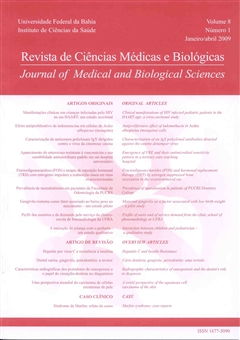Radiographic characteristics of osteoporosis and the dentist’s role in diagnosis
DOI:
https://doi.org/10.9771/cmbio.v8i1.4380Keywords:
Osteoporosis– Panoramic radiography – MandibleAbstract
Osteoporosis is a disease characterized by low bone mass and microarchitectural deterioration of bone tissue, leading to enhanced bone fragility and a consequent increase in fracture risk. Oral signs might be manifested by excessive alveolar ridge resorption, tooth loss, chronic destructive periodontal disease, referred maxillary sinus pain, or fracture. The diagnosis is based on bone mineral density as measured by dual energy X-ray absorptiometry. However, this method may not be of easy access in some countries. Then it has been proposed the use of oral radiography in the diagnosis, once they are habitually used in the planning of treatments. Many investigators have developed radiographic measures to evaluate osteoporotic manifestations in oral cavity, for example the Mandibular Cortical Index, Panoramic Mandibular Index and the technique described by Wical and Swoope. All this techniques use the basal area of the mandible posterior to the mental foramen as a standard area (smallest possible inter and intraindividual variations in anatomical size, shape, bone structure and function). Then the dentists may be able to refer patients to medical professionals for further examination on the basis of incidental findings on dental panoramic radiographs. Besides have access to bone quality, that is essential for a successful oral implant planning.Downloads
Download data is not yet available.
Downloads
Published
2009-07-23
How to Cite
Oliveira, L. S. de A. F., Neves, F. S., Torres, M. G. G., Crusoé-Rebello, I. M., & Campos, P. S. F. (2009). Radiographic characteristics of osteoporosis and the dentist’s role in diagnosis. Journal of Medical and Biological Sciences, 8(1), 85–90. https://doi.org/10.9771/cmbio.v8i1.4380
Issue
Section
Review Articles
License
The Journal of Medical and Biological Sciences reserves all copyrights of published works, including translations, allowing, however, their subsequent reproduction as transcription, with proper citation of source, through the Creative Commons license. The periodical has free and free access.


